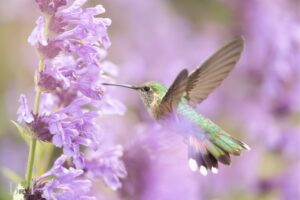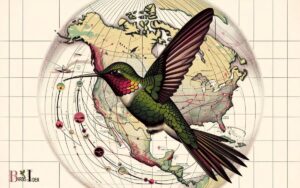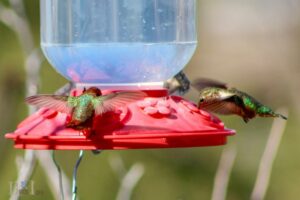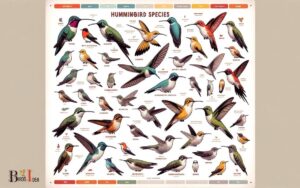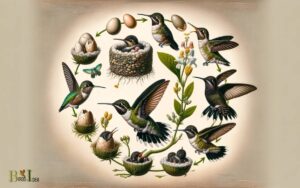Anna’s Hummingbird Nesting Behavior: 7 Stages!
Anna’s hummingbirds (Calypte anna) are known for their distinctive nesting habits. They typically breed from December through June, and during this period, females are solely responsible for nest construction and care of the young.
The nests are small, cup-shaped structures built out of plant down and spider webs, allowing them to expand as the chicks grow.
They are often located on tree branches or shrubs and can be found at various heights above ground. Females lay one to two eggs per clutch and may have multiple broods in a single season.
Anna’s hummingbirds exhibit several unique behaviors during their nesting period:
Anna’s hummingbirds adapt remarkably to urban environments, often building nests in parks and gardens, a testament to their resourcefulness and resilience.
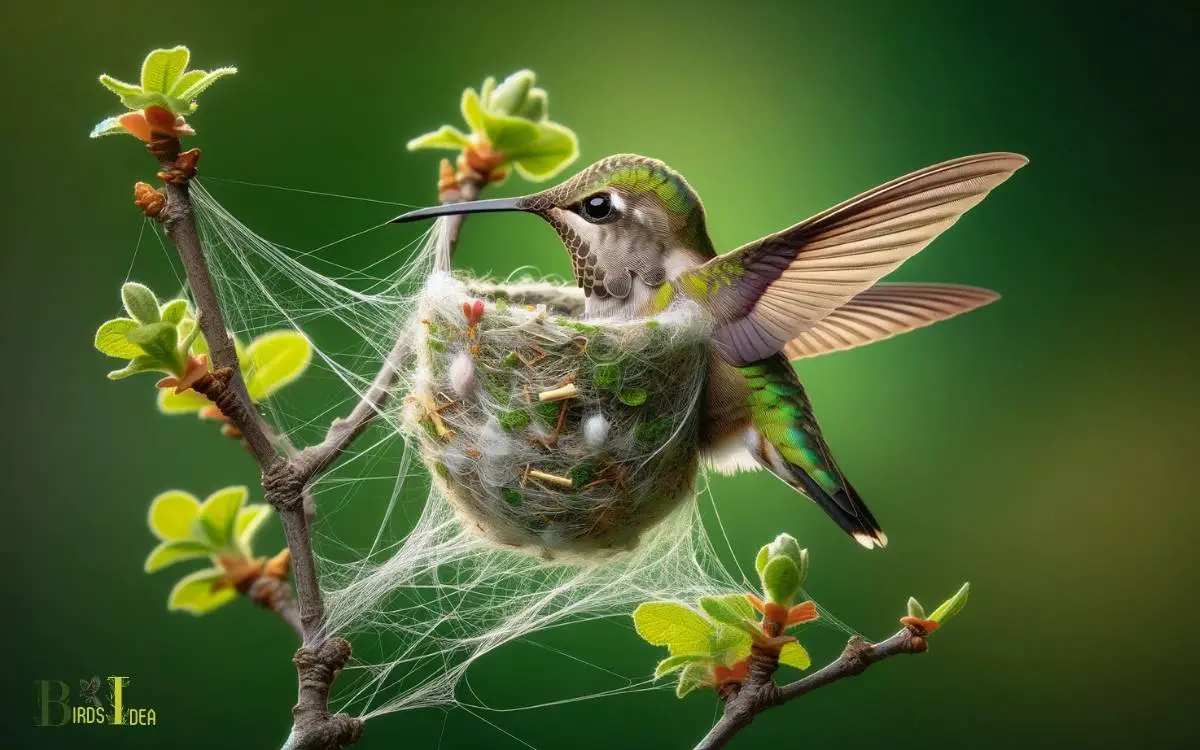
Key Takeaway
7 Stage of Anna’s Hummingbird Nesting Behavior
| Stage of Nesting Behavior | Description | Duration | Season |
|---|---|---|---|
| Site Selection | Female chooses a safe and sheltered location, often in trees or shrubs. | 1-3 days | Late winter/early spring |
| Nest Building | Using spider silk, plant down, and other materials, the female constructs a cup-shaped nest. | 5-7 days | Early spring |
| Egg Laying | Typically, the female lays 2 white eggs, about a day apart. | 2 days | Spring |
| Incubation | Female incubates the eggs, rarely leaving the nest for food. | 16-22 days | Spring |
| Hatching | Chicks use their egg tooth to break the eggshell and emerge. | 2-4 days | Late spring |
| Rearing | Female feeds the chicks with regurgitated food (insects and nectar). | 18-23 days | Spring to early summer |
| Fledging | Young hummingbirds leave the nest and learn to fly. | 18-28 days | Early to mid-summer |
Nest Location
Where does the Anna’s Hummingbird choose to build its nest? The Anna’s Hummingbird, a native of the western United States, typically selects a variety of locations for nest building.
These locations can include trees, shrubs, and even human-made structures such as wires or clotheslines.
The nest is often situated at a height of about 10 to 20 feet above the ground, providing a balance of protection and accessibility.
The female Anna’s Hummingbird is the primary architect of the nest, using materials such as plant fibers, downy seeds, and spider silk to construct a small, cup-shaped structure.
The nest is usually camouflaged with lichens and moss, blending seamlessly with the surrounding environment.
This choice of nesting location showcases the species’ adaptability and resourcefulness in finding suitable habitats for reproduction and raising their young.
Nest Construction
The female Anna’s Hummingbird meticulously constructs a small, cup-shaped nest using plant fibers, downy seeds, and spider silk. The process of nest construction is a remarkable display of avian engineering.
- The nest is often situated on a slender, downward-sloping tree branch, providing protection from the elements and potential predators.
- The outer portion of the nest is camouflaged with lichen and bits of bark, blending seamlessly with the surrounding environment.
- The inner lining consists of soft materials such as feathers, moss, and downy seeds, providing a cozy and insulating environment for the eggs.
- The female uses her beak to weave the materials together, forming a sturdy yet flexible structure that can accommodate the growing nestlings.
Nest Structure
The nest structure of the female Anna’s Hummingbird is a meticulously woven, cup-shaped form that provides a secure and insulating environment for the eggs and nestlings.
Constructed primarily of plant fibers, downy materials, and spider silk, the outer surface of the nest is often adorned with lichens and bits of bark, camouflaging it amidst the foliage.
The interior is delicately lined with soft plant fibers, feathers, and other insulating materials to maintain a stable microclimate, shielding the eggs and nestlings from temperature extremes.
The structure is remarkably resilient, expanding as the nestlings grow, yet durable enough to withstand the elements.
Its location is carefully chosen to provide protection from predators and adverse weather conditions, demonstrating the meticulous planning and instinctual wisdom of the female Anna’s Hummingbird.
Incubation Period
During the incubation period, the female Anna’s Hummingbird diligently maintains the warmth of the eggs within the intricately constructed nest.
This period is characterized by remarkable behaviors and adaptations:
- The female hummingbird sits on the eggs for the majority of the day, only leaving for short periods to feed and stretch.
- She carefully regulates the temperature by adjusting her position and fluffing her feathers to provide additional insulation.
- The eggs require a consistent temperature of around 98.6°F (37°C) for proper development, a task the female accomplishes with incredible precision.
- The incubation period usually lasts about 14 to 19 days, during which the female displays unwavering dedication to ensuring the survival of her offspring.
This remarkable process showcases the intricate and delicate nature of the Anna’s Hummingbird’s nesting behavior.
Feeding Behavior
During the nesting period, Anna’s Hummingbirds exhibit fascinating feeding behavior that includes frequent visits to flowers and feeders to replenish their energy reserves.
These tiny birds rely on a diverse diet of nectar, insects, and spiders to sustain themselves and their growing offspring.
The feeding interactions between adult birds and their nestlings also play a crucial role in the development and survival of the young hummingbirds.
Feeding Frequency and Types
Throughout the nesting period, Anna’s hummingbirds exhibit distinct feeding frequencies and types, revealing insights into their feeding behavior.
Feeding Frequency:
- The female hummingbird feeds approximately every 10-15 minutes during daylight hours to meet her high energy demands for egg incubation and maintaining her own health.
- The male hummingbird, responsible for defending the nesting territory, feeds less frequently, about every 30-45 minutes, and may occasionally take longer breaks to forage for nectar and insects.
Types of Feeding:
- The female primarily consumes nectar from flowers and feeders, occasionally supplemented with small insects for protein.
- The male focuses more on nectar consumption, relying on the quick energy it provides to sustain his territorial defense.
These feeding behaviors provide a fascinating glimpse into the strategies employed by Anna’s hummingbirds to ensure successful nesting and survival of their offspring.
Relationship With Offspring
The Anna’s hummingbirds exhibit a nurturing feeding behavior towards their offspring, playing a vital role in their development and growth.
The mother hummingbird regurgitates nectar and small insects into the open mouths of the chicks.
This provides them with essential nutrients, including proteins and fats required for their rapid growth.
The chicks are fed multiple times per hour, with the feeding frequency gradually decreasing as they grow older and become more independent.
The feeding behavior also serves as a means for the mother to bond with her offspring, establishing a strong maternal relationship.
This consistent and attentive feeding behavior ensures the healthy development of the chicks, preparing them for the next stage of their lives, the fledgling stage, when they will start to explore their surroundings and become more self-sufficient.
Fledgling Stage
During the fledgling stage, Anna’s Hummingbird chicks display distinct feeding behavior as they begin to explore their surroundings and develop their foraging skills.
The nest departure process is an essential aspect of this stage, as the young hummingbirds gain independence and learn to navigate the world on their own.
Throughout this phase, parental care continues to play a crucial role in ensuring the fledglings’ survival and successful transition to adulthood.
Fledgling Feeding Behavior
How does the fledgling feeding behavior of Anna’s hummingbirds differ from that of mature adults? The fledgling feeding behavior of Anna’s hummingbirds is distinct from that of mature adults.
When observing the interactions between fledglings and their parents, several notable differences become apparent:
- Frequency: Fledglings are fed more frequently than adults, with parents visiting the nest every 10-15 minutes to provide nourishment.
- Regurgitation: Unlike mature adults who feed on nectar, parents regurgitate a protein-rich substance directly into the fledglings’ mouths to meet their high energy demands.
- Learning: Fledglings observe and learn from their parents’ foraging techniques, gradually transitioning from being fed to self-foraging.
- Supervision: Parents closely monitor the fledglings during feeding, ensuring they receive adequate nutrition and coaching them in essential survival skills.
This intensive feeding regimen is crucial for the fledglings’ development and eventual independence.
Nest Departure Process
At the fledgling stage of Anna’s hummingbird nesting behavior, the nest departure process marks a pivotal transition for the young birds.
Fledglings typically leave the nest about 18-25 days after hatching, when they are fully feathered and capable of sustained flight.
Prior to departure, they often spend increasing amounts of time outside the nest, strengthening their flight muscles and honing their flying skills under the watchful eye of the mother.
The mother continues to feed and care for the fledglings for a period after they leave the nest, gradually encouraging them to become more independent.
The fledglings may return to the nest intermittently for a few days before fully dispersing from the nesting area.
This departure process is critical for the fledglings’ survival and successful integration into the broader hummingbird population.
Parental Care Role
During the fledgling stage, the parental care role of Anna’s hummingbird focuses on nurturing the fledglings’ independence and survival skills.
- The adult hummingbirds continue to feed the fledglings, but the frequency and amount of feeding decrease gradually.
- The fledglings are encouraged to explore their surroundings and learn to forage for nectar and insects on their own.
- Adults provide protection and guidance to the fledglings, teaching them how to avoid predators and navigate their environment effectively.
- Adult males may take on a more active role in defending the fledglings from potential threats, allowing the females to focus on foraging and feeding the young.
As the fledglings become more independent, the adult hummingbirds transition their focus to nest defense, ensuring the safety of their offspring from predators and other potential dangers.
Nest Defense
Nesting defense is a crucial aspect of Anna’s Hummingbird nesting behavior, essential for protecting the eggs and offspring from potential threats.
When a perceived threat approaches the nest, the female Anna’s Hummingbird exhibits remarkable defensive behavior. She may emit warning calls or engage in aggressive aerial maneuvers to deter the intruder.
These maneuvers include rapid darting flights, hovering in front of the intruder, or even dive-bombing them.
The male hummingbird also plays a role in nest defense, often joining the female in aggressive displays to protect the nest.
This coordinated defensive strategy helps to safeguard the vulnerable eggs and nestlings from predators such as snakes, jays, and other birds.
The instinctive and coordinated efforts of the parents ensure the survival of their offspring in the perilous environment of the nest.
Nesting Success
A high level of nesting success is achieved by Anna’s Hummingbirds through their vigilant nest defense and strategic parental coordination.
The success of Anna’s Hummingbird nesting can be attributed to several key factors:
- Strategic Nest Location: Anna’s Hummingbirds carefully select nesting sites that provide protection from predators and the elements, such as dense foliage or well-hidden branches.
- Meticulous Nest Construction: The female hummingbird constructs the nest with great care, using plant fibers, spider silk, and other materials to strengthen and camouflage the structure.
- Diligent Incubation: The female diligently tends to the eggs, maintaining optimal temperature and humidity levels for successful incubation.
- Coordinated Feeding: Both parents play an active role in feeding and caring for the nestlings, ensuring they receive a consistent and nutritious diet for healthy development.
Conclusion
The nesting behavior of Anna’s hummingbird is a fascinating display of dedication and precision.
These tiny birds construct their nests with remarkable skill, and the incubation period lasts for about 16-18 days.
The female is solely responsible for caring for the eggs and feeding the young. The nesting success rate is impressive, with a high percentage of eggs hatching and fledglings successfully leaving the nest.

